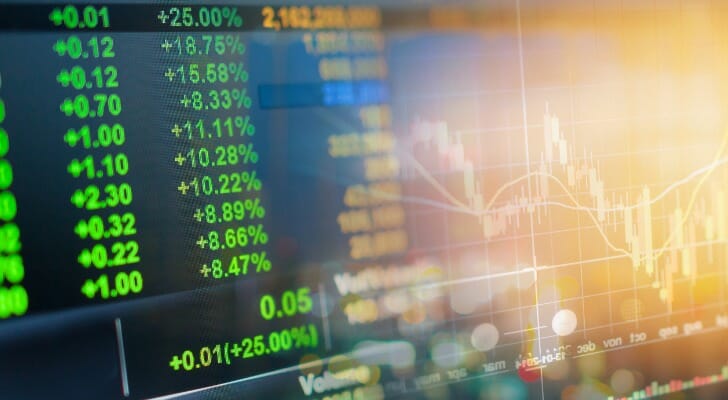 Risk is one of the most essential concepts to successful investing. Investors and capital-seekers looking for the right balance on any given security drive most market activity. Alpha measures an investment’s performance compared to a relevant market, like the Dow Jones or S&P 500. Here’s how alpha is measured and how it’s used in investing. You can also work with a financial advisor if you’re looking for help measuring your own portfolio.
Risk is one of the most essential concepts to successful investing. Investors and capital-seekers looking for the right balance on any given security drive most market activity. Alpha measures an investment’s performance compared to a relevant market, like the Dow Jones or S&P 500. Here’s how alpha is measured and how it’s used in investing. You can also work with a financial advisor if you’re looking for help measuring your own portfolio.
What Is Alpha?
 Alpha measures how an investment performs compared to a relevant market index over a specific time frame. For example, the alpha of a stock compared to the Dow Jones Industrial Average would express how much more the stock grew or fell compared to the Dow Jones overall.
Alpha measures how an investment performs compared to a relevant market index over a specific time frame. For example, the alpha of a stock compared to the Dow Jones Industrial Average would express how much more the stock grew or fell compared to the Dow Jones overall.
This metric is expressed as a percentage. An alpha of 0 means that the investment performed as well as the market. Meanwhile, 1 means the investment outperformed the comparison market by 1%. Finally, -1 means that the investment fell compared to the comparison market by 1%. However, it is not expressed as a percentage. As a result, it is often a whole number with the decimal dropped.
In one sense, it shows how an investment performs compared to a market-indexed fund. Therefore, investors often use it to examine a stock or mutual fund’s ability to “beat the market.” A fund with a high alpha performs significantly better than the market overall, indicating that it might be a sound investment. For example, say a stock-oriented mutual fund was to advertise an alpha of 3 As a result, it outperformed the stock market by 3%. In similar cases, a high-performance fund commonly uses S&P 500 as its benchmark index.
Alpha Is Not a “Greek”
In derivatives, particularly options, investors use a series of metrics called “the Greeks” to assess risk. Alpha is not a part of this set. The Greeks refer to a series of measurements that apply specifically to derivatives.
Meanwhile, an alpha measurement often applies to stocks, funds and related investments. Along with the related beta metric, alpha predates most of Greeks. Consequently, it’s likely that investors took the practice of using Greek letters from the existing use of those risk-related terms.
How To Use Alpha
 Seeking the alpha of a fund, portfolio, or other product is common when choosing investments. This is because they have a degree of stability that stocks often lack. A mutual fund can provide a stable, target alpha, for example. Meanwhile, a stock often performs far more erratically. As a result, the alpha of a financial product like a fund or portfolio is often more reliable than that of a stock or series of stocks.
Seeking the alpha of a fund, portfolio, or other product is common when choosing investments. This is because they have a degree of stability that stocks often lack. A mutual fund can provide a stable, target alpha, for example. Meanwhile, a stock often performs far more erratically. As a result, the alpha of a financial product like a fund or portfolio is often more reliable than that of a stock or series of stocks.
As noted earlier, the alpha of an investment indicates its performance against the overall market. However, there are a few key factors to consider when reviewing that metric:
- Time Frame: Investors measure an investment’s alpha over a specific period of time. Therefore, you can manipulate this metric by manipulating the period of time measured. Be certain that your future investment measures against a representative scope of time such as the last 12 months and not, say, the past week.
- Index: A comparative index also determines an investment’s alpha. The product should measure itself against a representative market where it’s bought and sold. A stock-based investment, for example, should be measured against the S&P 500 or the Dow Jones.
- Volatility: Finally, the alpha of a product does not necessarily represent that product’s volatility. A year-to-year performance 3% over the market might hide wide fluctuations within those 12 months. If the product’s annual performance satisfies you and you’re looking for a long-term investment, this may be less of a problem.
Alpha is also an essential element of the Capital Assets Pricing Model (CAPM). That formula measures the rate of return an investor should expect in exchange for a particular degree of risk.
Fee Against Alpha
When considering a fund, portfolio or other managed financial product, consider the product’s fee against its alpha rating.
Most financial products charge a management fee. It’s typically a certain percentage of that portfolio’s value. For example, a mutual fund might charge you 1% of its annual value in fees. Those fees pay the salaries and overhead associated with running a mutual fund.
Many investors consider their profit on any given product will be: Profit = Alpha – Fees. This is because the typical market index fund charges very little in fees (typically less than 0.1%, sometimes less than 0.4%). For example, say you have a fund with an alpha of 0.5% and an annual fee of 1%. You’ve paid half a percent more in fees than you received in performance, effectively a loss of almost half a percent given the alternative of a low-fee index fund.
The Bottom Line
When investors consider a product too risky to buy they avoid it. This makes organizations offer a greater return to offset that skittishness. A safe product doesn’t need to offer much return to attract investors eager for safe profit.
The more clearly you can understand a product’s risk profile the more accurately you can balance your own portfolio. However, no one can know for sure what an investment will do until after the fact. That doesn’t stop investors from trying to reduce the process to cold, hard numbers. That is where “Alpha” comes in.
Investing Tips
- If you’re uncertain how much investment risk you’re willing to take, you may want to consider talking to a financial advisor. Finding a financial advisor doesn’t have to be hard. SmartAsset’s free tool matches you with up to three vetted financial advisors who serve your area, and you can interview your advisor matches at no cost to decide which one is right for you. If you’re ready to find an advisor who can help you achieve your financial goals, get started now.
- Risk is just one portion of the investment equation. Do you know how much your investment needs to grow to reach your goals? How much will taxes and inflation take out of your investment. SmartAsset’s investing guide can help you answer some of the more fundamental investment questions.
Photo credit: ©iStock.com/Drazen_, ©iStock.com/primeimages, ©iStock.com/dima_sidelnikov